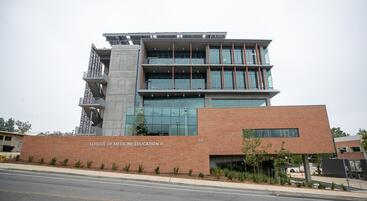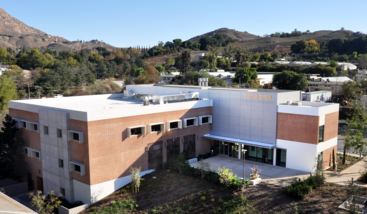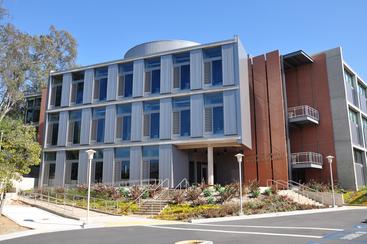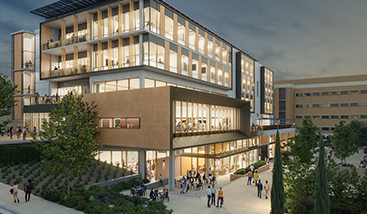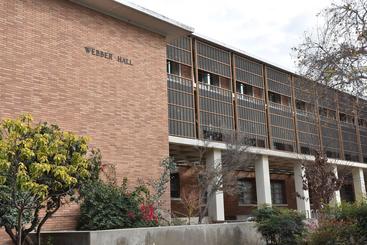
Facilities
School of Medicine Education Building
The School of Medicine Education II Building is 56,500 assignable square feet, and features four large classrooms and 15 case-based learning spaces as well as dedicated study spaces for our students. The building also has space for academic staff and administrators.
Formally opened with a groundbreaking on Sept. 26, 2023, the 95,478 square foot building was built with ultra-high strength, post-tensioned concrete, making it extremely strong. It meets LEED Platinum certification and is one of the most energy efficient buildings on campus with a 200KW solar array that helps provide power to the building.
The learning spaces include two large-scale classrooms for our first- and second-year medical students, which can be combined into a 7,000 square foot space with a capacity of more than 300. There is a tiered lecture hall with 136 seats and space for collaboration, and an 80-seat active learning classroom.
School of Medicine Education Building
Opened in 2012, the School of Medicine Education Building includes a 100-seat lecture hall, 10 patient examination rooms, problem-based-learning classrooms, a medical simulation laboratory, and administrative office space. The building received LEED-Silver certification in from the U.S. Green Building Council in January 2014. It was refurbished in 2023 following the completion of the SOM Education II Building.
The School of Medicine Education Building is home to:
- Anatomy lab
- A 100-seat lecture hall
- Administrative office spaces
- Small-group discussion rooms
School of Medicine Research Building
The three-story, 58,000-square foot School of Medicine Research Building is energy-efficient and advantageously designed to maximize space. The building incorporates high-level environmentally sensitive mechanical plans maximizing the use of natural ventilation, natural lighting, and other energy conservation measures. Scientific features of the building include open laboratories balanced by a significant component of individually-assignable laboratory support rooms, an equipment corridor model for shared instrumentation, and rooms for tissue culture, bioinformatics, autoclaves, microscopy and cytometry instrumentation.
The School of Medicine Research Building provides academic offices, research laboratory and support space for both biomedical sciences and clinical sciences faculty.
Architecture and landscape of the building feature a progressively green design that incorporates natural day light, minimum air change rates, chilled beams for lab space cooling, elimination of lab air re-heat and reduced pressure-drop HVAC systems.
Each research laboratory incorporates flexible and readily expandable laboratory planning modules that will accommodate new technologies or programmatic demands over the life of the building.
Research support space includes:
- Fluorescence-activated cell sorting room.
- Cell culture rooms.
- Controlled temperature rooms.
- Imaging rooms.
- Autoclave room.
- Bioinformatics space.
- Biosafety Level 3 Laboratory, the only such facility on the UCR campus.
Academic offices and support space includes:
- Faculty offices.
- Postdoctoral and graduate student space.
- Office support areas.
- Conference rooms/scholarly activity areas.
Clinical Skills & Simulation Suite at Orbach Library
Opened in 2021 and located in the basement of the Orbach Science Library, the Clinical Skills and Simulation Suite is part of the UCR School of Medicine's Center for Simulated Patient Care and is a state-of-the-art simulated patient training and education center that provides a secure, risk-free environment for current and future health care professionals to acquire and to perfect their skills. It consists of mock exam rooms, emergency room and intensive care simulation spaces, as well as small lecture spaces.
School of Medicine Education Building II
The School of Medicine Education Building II is scheduled to be completed in mid-2023. Located immediately south of the current SOM Education Building and east of Boyce Hall, the LEED platinum-certified facility will have approximately 57,000 assignable square feet within 90,000 gross square feet. The design features an urban downtown theme that includes outdoor seating, terraces, and landscaping that will complement the existing buildings around it.
In addition to lecture halls, small classroom and office space, the facility will also have an outdoor plaza that can be used for events.
Multidisciplinary Research Building (MRB)
Opened in 2019, the Multidisciplinary Research Building (MRB) is a 179,000-square-foot facility that supports up to 56 faculty investigators conducting research in areas including life sciences, chemical sciences, medicine and engineering. Located near the intersection of Aberdeen and North Campus Drives, the facility is the first LEED Platinum-certified project.
Herbert John Webber Hall
Herbert John Webber Hall houses the laboratories and offices of the current faculty in the School of Medicine Division of Biomedical Sciences. Originally constructed in the 1950s, with a number of laboratories since renovated, the building also contains faculty laboratories in the department of Plant Pathology and Microbiology.
Campuswide Research Facilities
These specialized research and instrumentation facilities, available to faculty researchers across the UCR campus, represent an important foundation for the School of Medicine and will work to support further expansion of biomedical research on campus.
Analytical Chemistry Instrumentation Facility
The facility is equipped to provide mass spectrometry and contains a variety of research instrumentation for the characterization of proteins and protein modifications including several mass spectrometers (such as a new GC-TOF mass spectrometer), X-ray crystallography, nuclear magnetic resonance, and an optical facility with a wide array of instrumentation including ultraviolet, visible, near infrared, FTIR and Laser Raman.
Bioinformatics Core Facility
Provides state-of-the-art bioinformatics and cheminformatic resources for large-scale comparative genomics, data mining, systems modeling and drug discovery. A wide range of modeling workstations, high-performance servers and supercomputers (Linux cluster) with several hundred scientific software tools are available for these tasks.
Central Facility for Advanced Microscopy and Microanalysis
The facility serves as a research, service and consulting laboratory for microscopic characterization (SEM, TEM) and contains two transmission electron microscopes and a scanning electron microscope for electron beam characterization of biological tissues.
Noel T. Keen Hall Genomics Core Instrumentation Facility
The facility contains a variety of tools supporting research in genomics and gene expression. The facility is equipped with research instrumentation for DNA sequencing, analysis of DNA libraries, and gene expression (quantitative PCR and phosphor/fluorescence imager) as well as a state-of-the art, high speed fluorescenceactivated cell sorter (FACS Aria) for cell separation and analysis.
Microscopy and Imaging Core Facility
Providing confocal microscopy, the facility contains a comprehensive suite of confocal microscopes for three-dimensional imaging of cells and cell structures, as well as a laser capture micro-dissection system that allow a detailed analysis of specific areas within complex tissues such as tumor tissue within a normal organ.
W.M. Keck Proteomics Laboratory
For proteomics mass spectrometry, the proteomics technology core is equipped with state-of-the-art mass spectrometers such as Q-TOF and Q-STAR that are complementary in system configuration for high sequence coverage and can perform high throughput peptide sequence analysis with high sensitivity and mass accuracy.
Stem Cell Core Facility
Constructed with funding from the California Institute of Regenerative Medicine (CIRM), this core facility contains resources for cell culture, molecular biology and cell imaging. A variety of services and training is offered by the Academic Coordinator who manages the facility.
Statistical Consulting Collaboratory
Provides statistical consulting and modeling to support decision-making in a variety of fields, such as survey sampling, quality control, product design and marketing.
